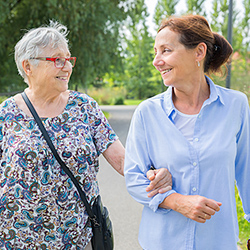
You are not alone in your journey as a caregiver.
“Those serving as caregivers for a loved one who has returned home after a stroke will play an active role in their recovery requiring anywhere from minimal to near total assistance with all of their daily activities and movement,” said Courtney Brown, DPT, a physical therapist at Baystate Rehabilitation Care.
According to Dr. Rajiv Padmanabhan of the Department of Neurology and director of the Stroke Program at Baystate Medical Center, rehabilitation after a stroke begins in the hospital.
Life After Stroke
“Depending on the patient’s condition, stroke rehabilitation should begin as soon as possible, optimally within 24 to 48 hours,” he said.
While some stroke survivors recover quickly and are able to return home (most stroke patients are in the hospital from 5-7 days) needing little to no assistance, others will need to undergo long-term rehabilitation at inpatient rehabilitation units, skilled nursing facilities, visits to outpatient units, and home-based programs like those offered by Baystate Home Health.
People can experience various disabilities after suffering a stroke. Therapists – including physical, occupational and speech – aim to reduce lasting damage and improve function with faster treatments that restore blood flow to the brain. Common disabilities after stroke can include loss of balance or coordination, speech loss, vision loss, and weakness or numbness of one part of the body. In the long term, some people experience movement problems, pain, numbness, thinking problems, speaking problems, or memory loss. Some also have emotional problems and depression.
Professionals can help
Brown noted rehabilitation professionals can help you learn how to provide the best care for your loved one, including:
- Help with functional mobility (transfers, bed mobility, walking, stairs)
- Help with activities of daily living (dressing, bathing, toileting, feeding, cooking, cleaning)
- Help with cognitive functions (aphasia, memory, word finding issues, delayed processing, impulsivity)
- Learning which assistive devices (walker, hemi-walker, cane, bracing, reacher/grabber) help your loved one stay safe during mobility and activities of daily living
- Continuation of home exercise program to maintain gains made in inpatient, home, or outpatient therapy
- Making modifications to the home to promote safety and reduce fall risk.
“Being a caregiver for your loved one after they have had a stroke can be very stressful. Don’t be hesitant to ask for or accept help from friends, family, and home health aides or personal care assistants to decrease your stress level,” said Brown.
Tips for Caregivers
Consider the following tips to help take care of yourself:
Accept Help
Use assistance from a home health aide or PCA to help with cleaning, laundry, cooking, dressing, bathing and toileting.
Give Yourself a Break
Give yourself a break. For example, if helpers at home are taking care of your loved one, spend some time reading a book, watching TV, going for a walk, taking a nap, or just sitting back and relaxing.
Find a Support Group
Find a support group – there are many support groups available online if you are unable to attend one in person.
Plan out your day
- Have a regular sleeping schedule
- Eat meals at similar times
- Do your home exercise program at similar times
- Give yourself and your love one enough time to get ready for medical appointments and recreational outings.
“Caregiving can be a very rewarding experience, but it has its challenges and stressors. Oftentimes caregivers are the primary person providing care 24-hours-a-day, and they need time to care for themselves as well,” said David Ahearn, MSW, LICSW, medical social worker, Baystate Home Health, Central Region.
Assistance to caregivers
“Area Agency on Aging services are available in every town and can provide assistance to caregivers,” he added.
Ahearn noted among the many services available to caregivers, depending on the agency, are caregiver support groups, information on resources and services within the community, educational classes on caregiving, counseling/emotional support, meal services, and more.
“Area Agency on Aging services can also offer respite services to give caregivers some short-term relief if the caregiver needs to leave the home for the afternoon or several days,” said Ahearn.
For more information on Area Agency on Aging services visit:
Find Rehabilitation Care and Support
After discharge from the hospital, Baystate Rehabilitation Care offers a full range of outpatient stroke rehabilitation services and a specialized neuro-rehabilitation therapy program to help stroke patients regain function.
If you have suffered a stroke, you can benefit from the services offered by Baystate Home Health including skilled nursing; home rehab including physical therapy, occupational therapy and speech/language pathology, social work, home health and telehealth.